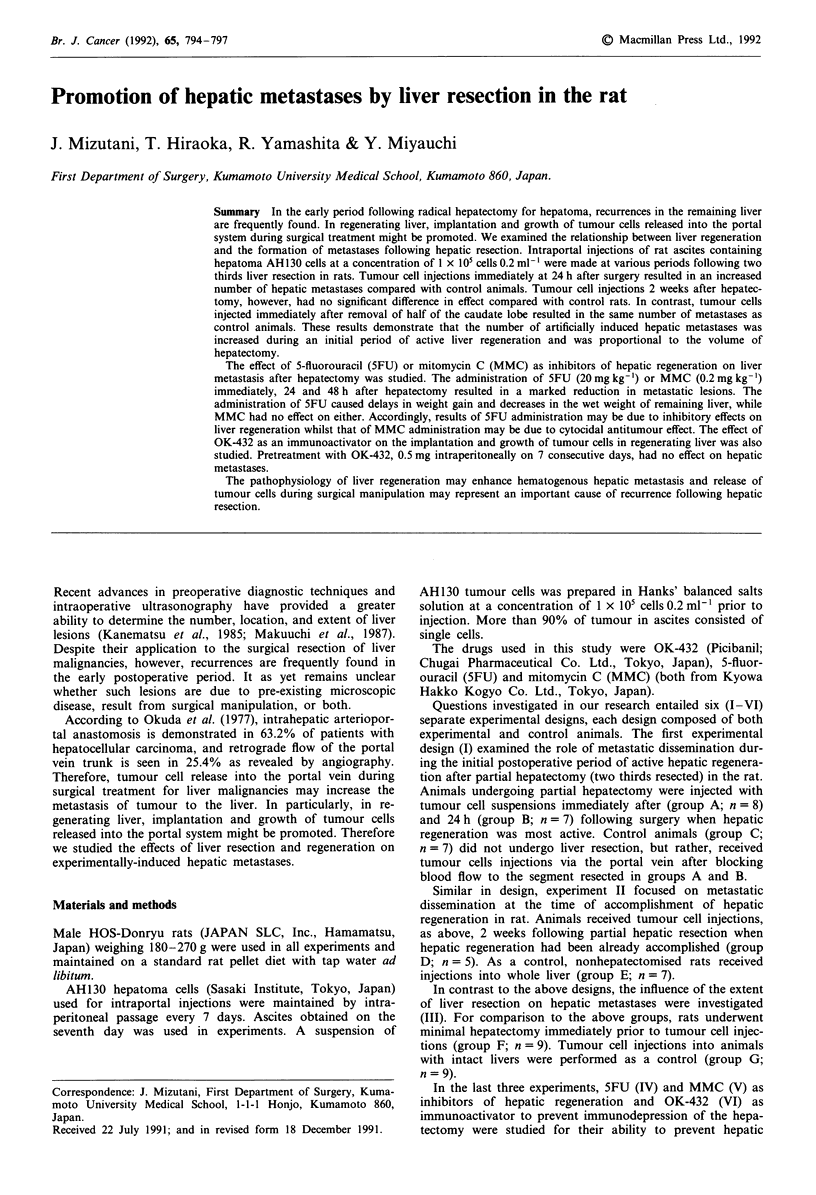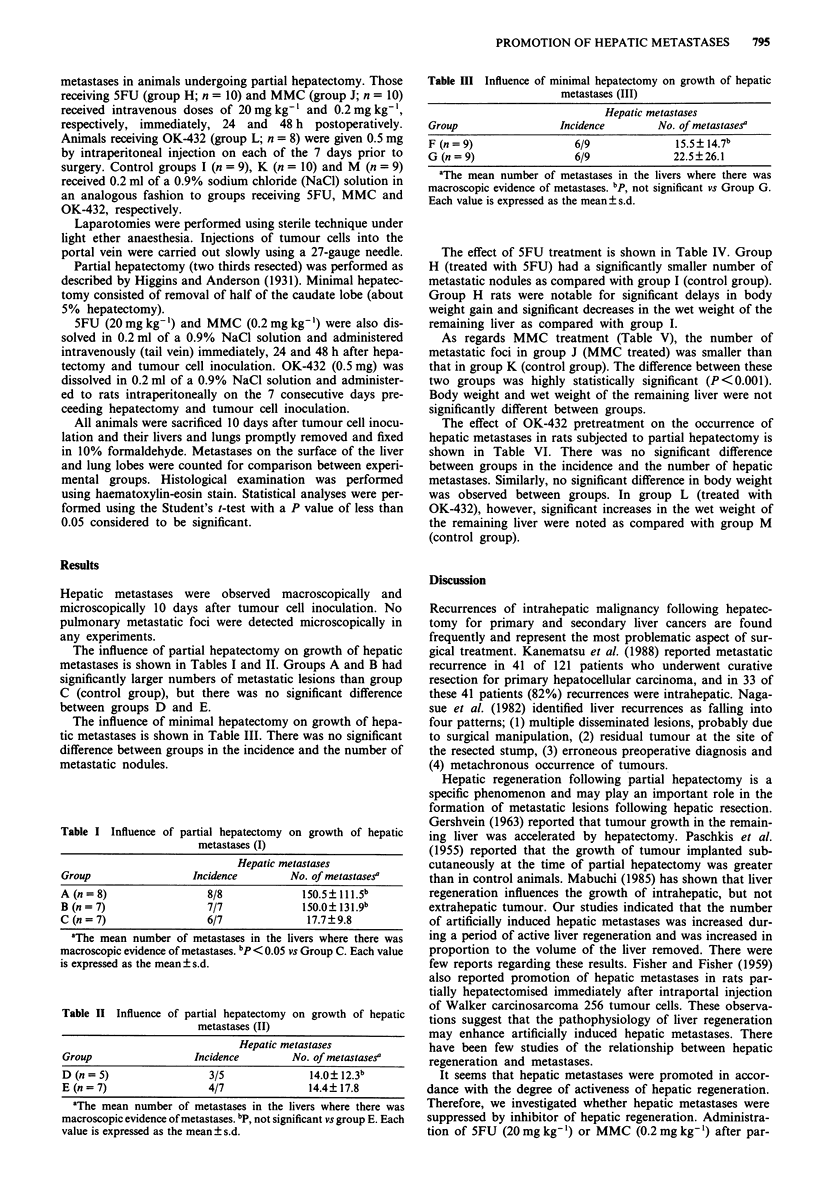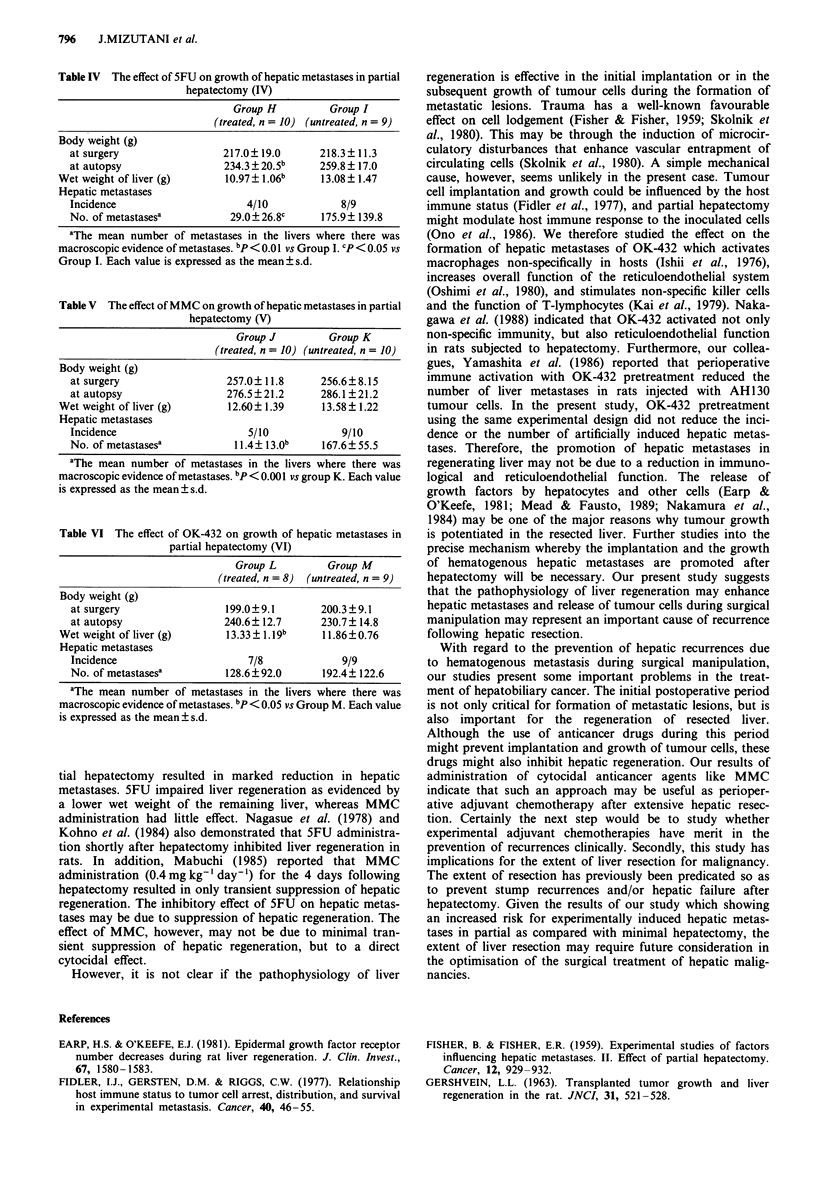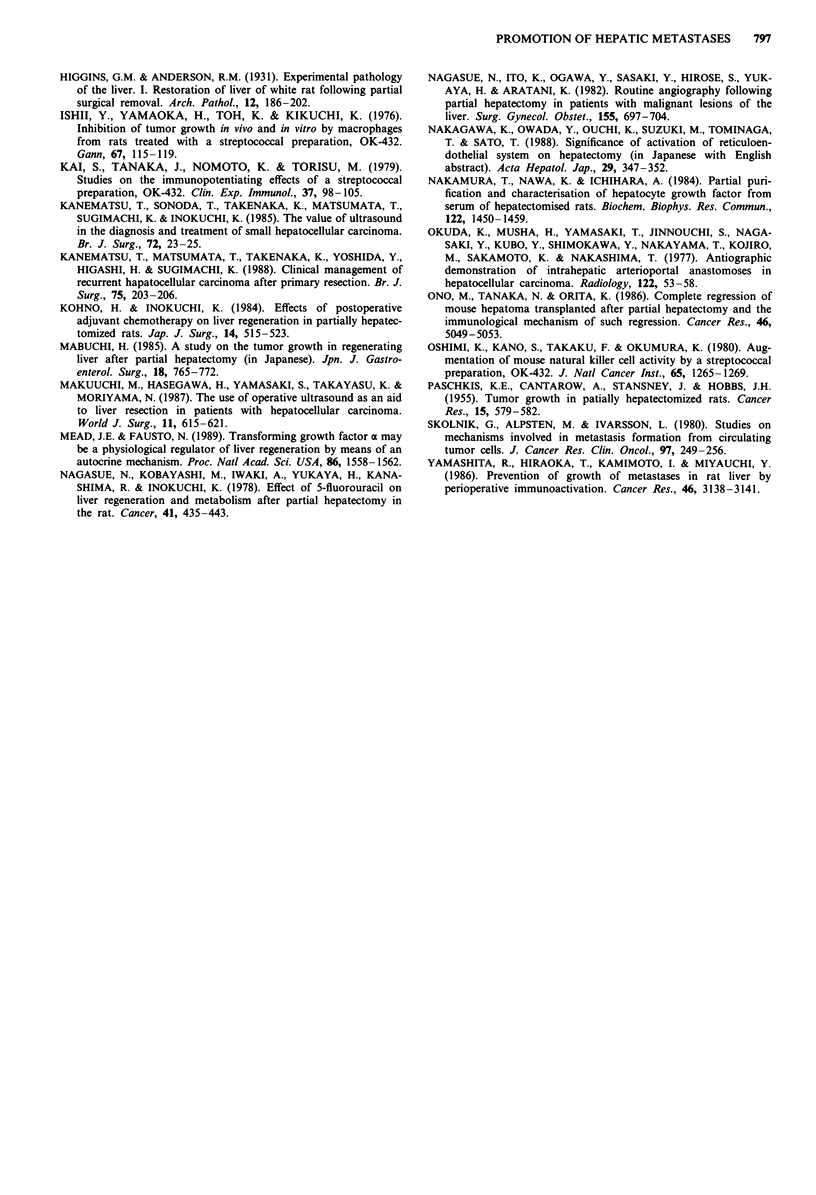Abstract
In the early period following radical hepatectomy for hepatoma, recurrences in the remaining liver are frequently found. In regenerating liver, implantation and growth of tumour cells released into the portal system during surgical treatment might be promoted. We examined the relationship between liver regeneration and the formation of metastases following hepatic resection. Intraportal injections of rat ascites containing hepatoma AH130 cells at a concentration of 1 x 10(5) cells 0.2 ml-1 were made at various periods following two thirds liver resection in rats. Tumour cell injections immediately at 24 h after surgery resulted in an increased number of hepatic metastases compared with control animals. Tumour cell injections 2 weeks after hepatectomy, however, had no significant difference in effect compared with control rats. In contrast, tumour cells injected immediately after removal of half of the caudate lobe resulted in the same number of metastases as control animals. These results demonstrate that the number of artificially induced hepatic metastases was increased during an initial period of active liver regeneration and was proportional to the volume of hepatectomy. The effect of 5-fluorouracil (5FU) or mitomycin C (MMC) as inhibitors of hepatic regeneration on liver metastasis after hepatectomy was studied. The administration of 5FU (20 mg kg-1) or MMC (0.2 mg kg-1) immediately, 24 and 48 h after hepatectomy resulted in a marked reduction in metastatic lesions. The administration of 5FU caused delays in weight gain and decreases in the wet weight of remaining liver, while MMC had no effect on either. Accordingly, results of 5FU administration may be due to inhibitory effects on liver regeneration whilst that of MMC administration may be due to cytocidal antitumour effect. The effect of OK-432 as an immunoactivator on the implantation and growth of tumour cells in regenerating liver was also studied. Pretreatment with OK-432, 0.5 mg intraperitoneally on 7 consecutive days, had no effect on hepatic metastases. The pathophysiology of liver regeneration may enhance hematogenous hepatic metastasis and release of tumour cells during surgical manipulation may represent an important cause of recurrence following hepatic resection.
Full text
PDF



Selected References
These references are in PubMed. This may not be the complete list of references from this article.
- Earp H. S., O'Keefe E. J. Epidermal growth factor receptor number decreases during rat liver regeneration. J Clin Invest. 1981 May;67(5):1580–1583. doi: 10.1172/JCI110190. [DOI] [PMC free article] [PubMed] [Google Scholar]
- FISHER B., FISHER E. R. Experimental studies of factors influencing hepatic metastases. II. Effect of partial hepatectomy. Cancer. 1959 Sep-Oct;12:929–932. doi: 10.1002/1097-0142(195909/10)12:5<929::aid-cncr2820120512>3.0.co;2-p. [DOI] [PubMed] [Google Scholar]
- Fidler I. J., Gersten D. M., Riggs C. W. Relationship of host immune status to tumor cell arrest, distribution, and survival in experimental metastasis. Cancer. 1977 Jul;40(1):46–55. doi: 10.1002/1097-0142(197707)40:1<46::aid-cncr2820400110>3.0.co;2-t. [DOI] [PubMed] [Google Scholar]
- GERSHBEIN L. L. TRANSPLANTED TUMOR GROWTH AND LIVER REGENERATION IN THE RAT. J Natl Cancer Inst. 1963 Sep;31:521–528. [PubMed] [Google Scholar]
- Ishii Y., Yamaoka H., Toh K., Kikuchi K. Inhibition of tumor growth in vivo and in vitro by macrophages from rats treated with a streptococcal preparation, OK-432. Gan. 1976 Feb;67(1):115–119. [PubMed] [Google Scholar]
- Kai S., Tanaka J., Nomoto K., Torisu M. Studies on the immunopotentiating effects of a streptococcal preparation, OK-432. I. Enhancement of T cell-mediated immune responses of mice. Clin Exp Immunol. 1979 Jul;37(1):98–105. [PMC free article] [PubMed] [Google Scholar]
- Kanematsu T., Matsumata T., Takenaka K., Yoshida Y., Higashi H., Sugimachi K. Clinical management of recurrent hepatocellular carcinoma after primary resection. Br J Surg. 1988 Mar;75(3):203–206. doi: 10.1002/bjs.1800750305. [DOI] [PubMed] [Google Scholar]
- Kanematsu T., Sonoda T., Takenaka K., Matsumata T., Sugimachi K., Inokuchi K. The value of ultrasound in the diagnosis and treatment of small hepatocellular carcinoma. Br J Surg. 1985 Jan;72(1):23–25. doi: 10.1002/bjs.1800720111. [DOI] [PubMed] [Google Scholar]
- Kohno H., Inokuchi K. Effects of postoperative adjuvant chemotherapy on liver regeneration in partially hepatectomized rats. Jpn J Surg. 1984 Nov;14(6):515–523. doi: 10.1007/BF02469796. [DOI] [PubMed] [Google Scholar]
- Makuuchi M., Hasegawa H., Yamazaki S., Takayasu K., Moriyama N. The use of operative ultrasound as an aid to liver resection in patients with hepatocellular carcinoma. World J Surg. 1987 Oct;11(5):615–621. doi: 10.1007/BF01655837. [DOI] [PubMed] [Google Scholar]
- Mead J. E., Fausto N. Transforming growth factor alpha may be a physiological regulator of liver regeneration by means of an autocrine mechanism. Proc Natl Acad Sci U S A. 1989 Mar;86(5):1558–1562. doi: 10.1073/pnas.86.5.1558. [DOI] [PMC free article] [PubMed] [Google Scholar]
- Nagasue N., Ito K., Ogawa Y., Sasaki Y., Hirose S., Yukaya H., Aratani K. Routine angiography following partial hepatectomy in patients with malignant lesions of the liver. Surg Gynecol Obstet. 1982 Nov;155(5):697–704. [PubMed] [Google Scholar]
- Nagasue N., Kobayashi M., Iwaki A., Yukaya H., Kanashima R., Inokughi K. Effect of 5-fluorouracil on liver regeneration and metabolism after partial hepatectomy in the rat. Cancer. 1978 Feb;41(2):435–443. doi: 10.1002/1097-0142(197802)41:2<435::aid-cncr2820410209>3.0.co;2-h. [DOI] [PubMed] [Google Scholar]
- Nakamura T., Nawa K., Ichihara A. Partial purification and characterization of hepatocyte growth factor from serum of hepatectomized rats. Biochem Biophys Res Commun. 1984 Aug 16;122(3):1450–1459. doi: 10.1016/0006-291x(84)91253-1. [DOI] [PubMed] [Google Scholar]
- Okuda K., Musha H., Yamasaki T., Jinnouchi S., Nagasaki Y., Kubo Y., Shimokawa Y., Nakayama T., Kojiro M., Sakamoto K. Angiographic demonstration of intrahepatic arterio-portal anastomoses in hepatocellular carcinoma. Radiology. 1977 Jan;122(1):53–58. doi: 10.1148/122.1.53. [DOI] [PubMed] [Google Scholar]
- Ono M., Tanaka N., Orita K. Complete regression of mouse hepatoma transplanted after partial hepatectomy and the immunological mechanism of such regression. Cancer Res. 1986 Oct;46(10):5049–5053. [PubMed] [Google Scholar]
- Oshimi K., Kano S., Takaku F., Okumura K. Augmentation of mouse natural killer cell activity by a streptococcal preparation, OK-432. J Natl Cancer Inst. 1980 Dec;65(6):1265–1269. [PubMed] [Google Scholar]
- PASCHKIS K. E., CANTAROW A., STASNEY J., HOBBS J. H. Tumor growth in partially hepatectomized rats. Cancer Res. 1955 Oct;15(9):579–582. [PubMed] [Google Scholar]
- Skolnik G., Alpsten M., Ivarsson L. Studies on mechanisms involved in metastasis formation from circulating tumor cells. Factors influencing tumor cell lodgement during normal and post-traumatic conditions. J Cancer Res Clin Oncol. 1980;97(3):249–256. doi: 10.1007/BF00405776. [DOI] [PubMed] [Google Scholar]
- Yamashita R., Hiraoka T., Kamimoto I., Miyauchi Y. Prevention of growth of metastases in rat liver by perioperative immunoactivation. Cancer Res. 1986 Jun;46(6):3138–3141. [PubMed] [Google Scholar]


